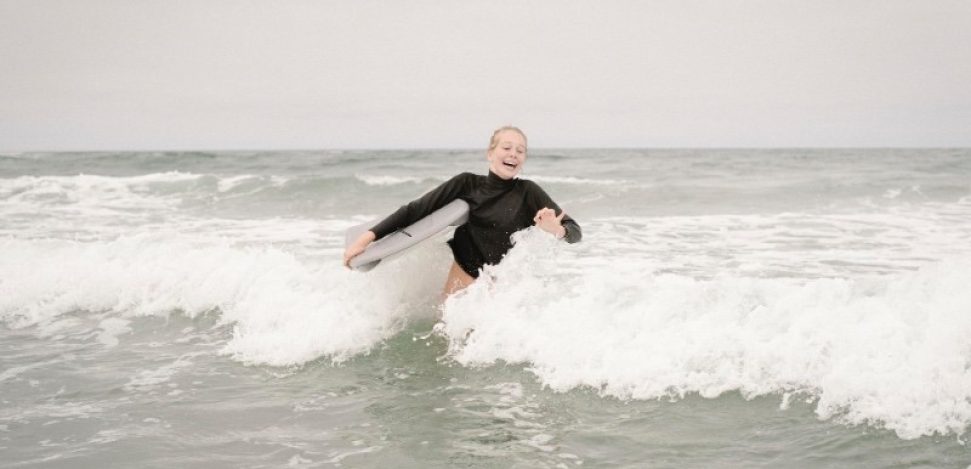You’re contemplating taking up a summer water sport in the ocean, and you’re stuck deciding between giving bodyboarding or surfing a shot. If you’re unsure about which one would be a better fit, then this post is for you.
Both bodyboarding and surfing for beginners are achievable, so let’s delve into some factors to assist you in making this decision.
General Sporting Ability
Your competence as a swimmer is a prerequisite before taking up bodyboarding or surfing.
Once you establish that, the primary factor in deciding between these two sports is your overall sporting ability and coordination.
It is a more straightforward sport to pick up and master compared to surfing.
If you’re someone with a versatile skill set in various sports, giving surfing a try might appeal to you. On the other hand, if you’re not particularly athletic or struggle with coordination, surfing can be quite challenging.
However, if you’re not very sporty but still keen on trying surfing, go for it! Just be aware that catching a wave might require effort, so don’t get discouraged.
For kids, it’s best to start surfing at a surf school, given the technical nature of the sport. Encourage them to establish good habits early on, and let them know it might be a bit tricky initially. Remember, practice makes perfect!
Surfing for beginners: The best tips and tricks
Invented in California
The bodyboard, also known as a boogie board or belly board, was created by Tom Morey in July 1971 in Southern California.
Tom Morey, a Detroit-born inventor with a passion for surfing, faced a challenge when he only had a foam blank, a rectangular piece of stoke. As an engineer, musician, surfer, and shaper, Morey innovatively cut a nine-foot piece of polyethylene foam in half. He placed a sheet of newspaper on the foam, ironing out the first-ever bodyboard shape.
Morey rode the inaugural wave on this bodyboard prototype at Honls, with his wife, Marchia, being the second person to experiment with what would evolve into a global success story.
Reflecting on his revolutionary invention, Morey expressed, “I could feel the wave through the board. On a surfboard, you’re not feeling every nuance of the wave, but with my creation, I could feel everything.” Recognizing its potential, he thought, “It turns, it’s durable, it can be made cheaply, it’s lightweight, it’s safe. God, this could be a really big thing!”
Morey Boogie emerged as an iconic brand and a synonymous term for bodyboarding. The world’s first bodyboarding company has endured the fluctuations of the surf industry and continues to thrive, marketing new models.
<iframe width=”750″ height=”422″ src=”https://www.youtube.com/embed/8-0r4kb4JWE” title=”2020 World Cup Gran Canaria Frontón King | Final Highlights” frameborder=”0″ allow=”accelerometer; autoplay; clipboard-write; encrypted-media; gyroscope; picture-in-picture; web-share” allowfullscreen></iframe>
Is Bodyboarding Easier Than Surfing?
Bodyboarding proves to be an easier sport to learn compared to surfing, primarily due to its safety aspects. Here’s why:
-
Proximity to Waves: You don’t need to venture far from the shore to catch a wave on a bodyboard. Even small waves can propel you, eliminating the challenge of navigating deep waters while learning to control a board.
-
Ease of Catching Waves: Catching waves on a bodyboard is simpler and requires less precise timing than surfing. This allows for better wave control early in the learning process.
-
Early Enjoyment: The ability to catch waves sooner in the initial stages makes it more enjoyable from the start.
-
Paddling Technique: Using your legs to paddle out into the waves is easier in bodyboarding compared to the use of arms in surfing.
-
Safety for Young Kids: Learning to bodyboard can take place in shallower waters, offering a safer option for very young kids who may not feel confident in deeper surf. This also means you can teach kids to bodyboard without relying on a school.
-
Reduced Falling Risk: The likelihood of falling off a bodyboard is lower than with surfing. Additionally, the initial experience feels less turbulent since you’re lying flat on the bodyboard rather than standing on a surfboard.
Believe Bodyboarding Is Dull?
The ongoing rivalry between bodyboarders and surfers often leads to unnecessary comparisons, as both are distinct sports with their own merits. Each sport offers unique experiences, and bodyboarding has its exciting aspects that may surprise those who consider it boring. Here are some points to challenge the notion that this water sport lacks excitement:
-
Close to Bodysurfing: Bodyboarding closely resembles bodysurfing, placing your body near the water, creating the illusion of breaking waves over you.
-
Enhanced Propulsion: Wearing fins enables more powerful and faster propulsion, allowing you to ride stronger waves and achieve greater speed.
-
Vertical Drops: Unlike surfers, bodyboarders can drop into vertical waves while lying down.
-
Bigger Air: Bodyboarders can achieve more significant air compared to surfers, capitalizing on the power of waves, especially when assisted by fins. The legs provide more power than the arms.
-
Quick Entry: Bodyboarders can enter waves faster, wave-riding closeout waves that surfers may find challenging.
-
Tricks and Maneuvers: Once you master riding waves instead of just catching them, bodyboarding offers the opportunity for various twists, turns, and cutbacks, allowing for tricks and maneuvers.
While catching massive waves might offer an unparalleled adrenaline rush, this perspective is geared toward the everyday individual, not those venturing out to challenging spots like Nazaré. It acknowledges the considerations that mere mortals, especially beginners, might have before tackling substantial waves.
The Practical Side of Bodyboarding
From a practical standpoint, it presents several advantages over surfing, making it a more budget-friendly and convenient option, especially for growing families. Here are some practical benefits:
-
Affordability: Bodyboards are significantly cheaper than surfboards. Even for serious enthusiasts, a professional bodyboard is half the cost of a good surfboard, offering a cost-effective entry point.
-
Ease of Carrying: Due to their smaller size and lighter weight, bodyboards are easier to carry. One person can carry multiple bodyboards in a single bag, simplifying transportation.
-
Convenient Transport: Transporting bodyboards to the beach is hassle-free. No need for roof racks or surfboard racks, as everything easily fits in the car’s trunk. This also makes it more convenient for air travel, with the bag easily checked in at the airport.
-
Space-efficient Storage: Storing bodyboards at home is simple and requires less space compared to surfboards.
-
Cost-Effective Repairs: If a bodyboard gets damaged, repairs are less costly than those for surfboards. In many cases, replacing a damaged bodyboard might be more practical rather than investing in extensive repairs.
SUBWING: FLYING UNDERWATER! DO YOU DARE?
Great Introduction to the Surf
For those who are true beginners and unfamiliar with the surf, starting with bodyboarding before attempting surfing is a wise choice, as it is a form of surfing!
It provides a gentle introduction to the ocean, making it an excellent starting point for young kids and less experienced individuals interested in surfing. It offers a balanced mix of play, sport, and water learning, helping participants understand surf conditions.
Additionally, this sport serves as a valuable tool for learning how to maneuver in the surf. It teaches crucial aspects such as recognizing when waves break, understanding peak points, and mastering timing. As comfort grows, individuals may transition to surfing with a solid foundation gained through bodyboarding.





 smokingpaper
smokingpaper



























